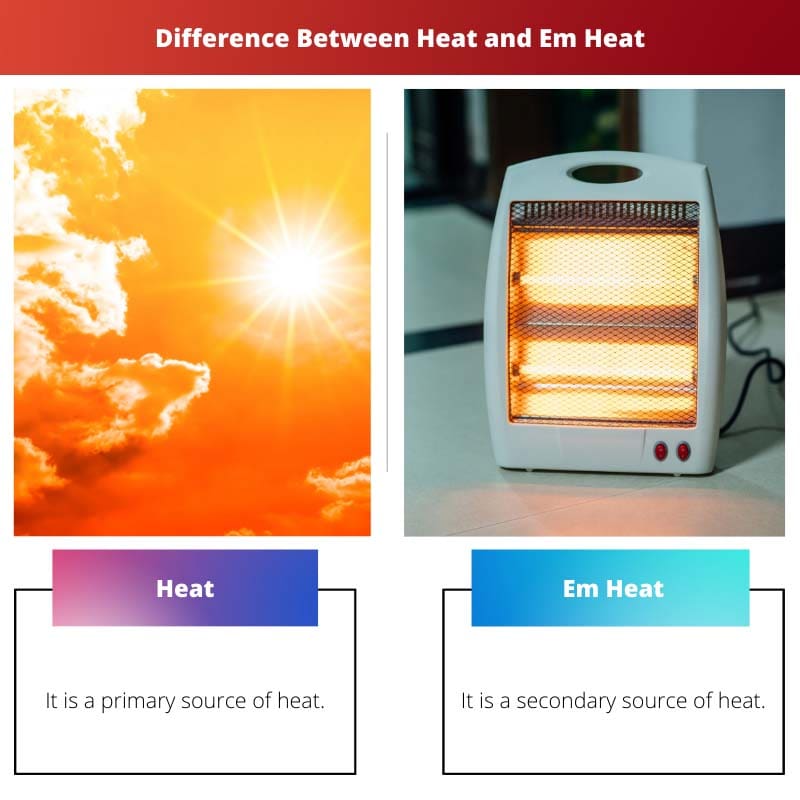Heat and em heat are two settings or functions one can find in a thermostat. The heat function in a thermostat is self-explanatory and is used during winter.
However, people see em heat as simply heat. Some may be confused or may not have any idea about em heat. Hence it is very important to know that these two play very different roles.
Key Takeaways
- Heat is a mode on most thermostats that activates the heating system to maintain a set temperature.
- EM heat, or emergency heat, is an auxiliary heating option found on heat pumps, used when the primary system fails or struggles in freezing temperatures.
- Relying on EM heat can be less energy-efficient and more expensive, so it should be reserved for emergencies or temporary solutions.
Heat vs Em Heat
The difference between heat and em heat is that heat is used as a primary setting in a thermostat, whereas em heat is a secondary option of heating. Heat in a rheostat is a general type of setting which is very well known. However, em heat is special and is rarely used in day-to-day life.

Heat is the sensation of warmth. We feel the heat in our day-to-day life. In terms of science, heat is a form of energy that naturally flows from a hot to a cold object.
It transfers from one object to another when the two objects have a certain difference in temperature. However, when seen from the thermostat point of view, heat is just a form of energy that provides us warmth.
Em heat stands for emergency heat. It is an alternative backup plan which is reserved for emergencies. It is not used regularly but can be a lifesaver during emergencies.
Em heat is a setting that is present in many of the thermostats. In case of the primary heating system failure, em heat comes to the rescue.
Comparison Table
| Parameters of Comparison | Heat | Em Heat |
|---|---|---|
| Used as | It is a primary source of heat. | It is a secondary source of heat. |
| Requirements | It requires a heat pump. | It requires oil, gas furnace, electrical heating strip, etc. |
| Frequency of use | It is used regularly. | It is used occasionally. |
| Type of term | It is a general term. | It is a term used concerning a thermostat. |
| Type of Setting | It is a general setting. | It is a special setting. |
What is Heat?
Heat can be referred to as warmth. Heat, in terms of science, has a different explanation. It is the flow of energy between two objects due to the difference in temperature between them. Heat is something every living thing on this planet requires to stay alive.
The sun is our main source of heat. Other sources of heat include natural gas, coal, wood, electricity, etc. These sources of heat are used when the temperature in the atmosphere starts falling. Another source of temperature control is a thermostat when used in association with a heat pump.
The heat pump works as a primary source of heat when the temperature falls. In general, when the temperature falls down, the heat pump starts working automatically.
One can also turn the heat setting manually when needed. The heat pump is placed outside of the house to collect heat when the temperature falls.
The heat pump is responsible for keeping the house warm during winter. The heat pump collects heat from outside; hence no extra energy is used to generate the heat.
Heat pumps are a lifesaver in cold places and are almost used on a daily basis. However, if this heat pump stops working, we would then require a secondary heat source, which is when Em heat comes to the rescue.

What is Em Heat?
Em heat stands for emergency heat. One can find a setting or function in a thermostat when the thermostat is associated with a heat pump. As the name suggests, em heat is used during emergencies. It is a secondary source of heat.
It is used as a backup. All regular thermostats have this setting. Sometimes in cold places, the primary heat pump source may stop working due to very low outside temperatures. It may even get frost due to very cold weather. This is when the em heat function automatically starts working.
In different types of thermostats, this automatic starting of the em heat may or may not be present. One may have to start it manually. This secondary source of heating could be from oil, gas furnace, electrical heating strip, hot water furnace, etc.
However, it is important to think twice before one starts the em heat manually. This is because once you turn on the em heat setting, the heat pump, which is the primary source of heating, will stop working, and the entire heating system of the house gets dependent on the secondary heat.
This could be quite expensive and will increase your electricity bill.
If one starts the em heat function by mistake, it can be easily stopped by pressing the em heat button again. Overall it could be concluded that the em heat setting should only be used when the heat pump stops working due to some reason.

Main Differences Between Heat and Em heat
- Heat setting is present in all thermostats, whereas Em heat setting may or may not be present in a thermostat.
- Heat is provided by a heat pump whereas em heat is provided by oil, gas furnace, electrical heating strip, hot water furnace, etc.
- Heat is a general setting in a thermostat, whereas em heat is a special setting in a thermostat.
- Heat is a primary setting, whereas em heat is a backup or secondary setting.
- Heat is a general term used in day-to-day life, whereas em heat is a term related to thermostats.




